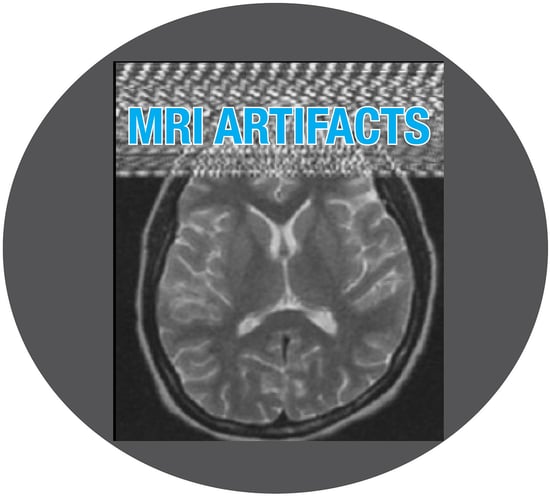Magnetic Resonance Imaging (MRI) uses magnetic fields and radio waves to form images of the body.  Radiologists read these images to help diagnose a lot of different health conditions. Sometimes structures or “artifacts” can appear in MRI imaging but aren’t actually anatomically present. This can lead to improper diagnoses, so it’s important to be able to recognize common artifacts.
Radiologists read these images to help diagnose a lot of different health conditions. Sometimes structures or “artifacts” can appear in MRI imaging but aren’t actually anatomically present. This can lead to improper diagnoses, so it’s important to be able to recognize common artifacts.
Almost every MRI exam includes some kind of artifact. There are three primary types of MRI artifacts: Physiologic, Inherent Physical Artifacts and Hardware/Software Artifacts.
Physiologic Artifacts are those caused by patient motion during the MRI. These can be caused by cardiac movement, breathing, CSF pulsation/blood flow or patient movement that is intentional or not. They typically look like blurring or ghosting, especially in the phase-encoding direction. It’s very important to instruct a patient to hold still during the exam in order to reduce the possibility of motion artifacts since these can help radiologists diagnose patients as accurately as possible. Sometimes patients might even require an antispasmodic medication to reduce the possibility of motion artifacts. A radiologist also mighty reduce motion artifacts by using echo-planar imaging (EPI), which is a very fast MRI technique.
Inherent Physical Artifacts are artifacts that are caused by the inherent physics of an MRI, like the presence of metal or chemical shift. Chemical shift artifacts happen during the frequency encoding of the MRI process. However, they tend to be less prominent on T1-weightd images than on T2-weighted images. Fat and water molecules show up differently during encoding because they oscillate differently within the magnetic field. This creates a bright or black band at the edge of the patient’s anatomy and sometimes is misinterpreted as pathology. This kind of artifact can be minimized by increasing the bandwidth, suppressing the fat-frequency signal or reducing the matrix size.
When a patient has an implant or medical device in the MRI room that responds to the magnetic field, magnetic susceptibility artifacts can occur.
This causes the image to have dark areas and bright areas near the magnetic object that are not anatomically correct. By avoiding gradient echo sequences, this effect can be reduced. However, sometimes this type of artifact can actually be useful in diagnosing patients, especially in the detection of hematomas. These artifacts can also enhance the image quality when used in certain circumstances. In addition, metallic objects within the patient’s body or also on the patient can result in FLAIR-hyperintensity due to a magnetic susceptibility artifact.
There are three types of artifacts caused by metallic and other foreign bodies that are found in and one patients’ bodies.
- Foreign bodies that are connected with outfit or ornamentation of the body, like make-up, hair accessories, clothes and clothing labels. This can also include medical equipment like hearing aids.
- Foreign bodies that can’t be eliminated like, surgical/neurosurgical staples or clips, dental implants and endoprostheses.
- Foreign bodies that patients have forgotten to tell MRI unit personnel about or don’t know about them, like a stent graft or other medical implants.
In additional, spike noise artifacts caused by static electricity from clothing or blankets resemble checkered patterns on the clothes. This can be caused by acrylic materials.
Hardware/Software Artifacts
When something in the environment interferes with an MRI unit, it can create noise on the image which makes it difficult to read. These “zipper” artifacts can be caused by blinking light bulbs, the door to the MR Room not being securely closed, or even noise from nearby construction. By removing the source of the interference the artifact can be eliminated. By locating the MR room in an isolated area that’s strictly controlled, the chance of interference can be minimized.
Conclusion
Yes, there are many types of artifacts and many different causes of them. When radiologists can identify them and minimize their effects, it’s easier to make correct diagnoses.
Talk To An Expert
Are you looking for a medical imaging equipment for your healthcare facility? If so, be sure to consider buying a refurbished or used MRI, CT Scanner or C-Arm machine. You can oftentimes get the performance you want, at a much lower cost—and still enjoy impressive warranties. Talk to the experts at Atlantis Worldwide.
Some blogs you may have missed:
- The Future of Helium & MRIs
- MRI Cold Head Tips
- How Much Is Your MRI Worth?
- Solutions For MRI Coil Failure
- Should your business lease or buy medical imaging equipment?
- Free MRI Resources
Meet the author: Vikki Harmonay



